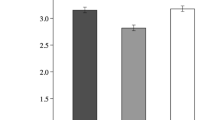Abstract
This paper investigates a referendum held in 1994 on the public support of the Zürich Opera House. The estimates demonstrate that well over 85% of the variance in the approval rates across ballot districts can be explained with a few variables characterizing the socio-economic composition of the electorate. Since these variables have been shown to influence the level of public support for the arts in representative democracies as well, our result lends support to the view that in democracies public support for the arts is coupled to the stable preferences of the electorate. This insight may, to some extent, mitigate and qualify existing fears that cultural policy is completely at the mercy of changing government ideologies and interest group influences.
Similar content being viewed by others
References
Amemiya, Takeshi (1985). Advanced econometrics. Cambridge, Mass.: Harvard University Press.
Baumol, W. and Bowen, W. (1966). Performing arts: The economic dilemma. Cambridge, Mass.: Twentieth Century Fund.
Becker, G. (1996). Accounting for tastes. Cambridge, MA: Harvard University Press.
Bernholz, P. (1974). On the reasons for the influence of interest groups on political decision making. Zeitschrift für Wirtschafts-und Socialwissenschaft 94: 45–63.
Bille Hansen, T. (1997). The willingness-to-pay for the Royal Theatre in Copenhagen as a public good. Journal of Cultural Economics 21: 1–28.
Bishop, R.-C., Heberlein, T. (1986). Does contingent valuation work? In: R. Cummings, D. Brookshire and W. Schulze (Eds.). Valuing environmental goods: An assessment of the contingent valuation method, 123–147. Totowa, N.J.: Littlefield, Adams; Rowman and Allanheld.
Carson, R. and Mitchell, R. (1989), Using surveys to value public goods: The contingent valuation method. Washington, D.C.: Resources for the future.
Diamond, P.A. and Hausman, J.A. (1994). Contingent valuation: Is some number better than no number? Journal of Economic Perspectives 8: 45–64.
Frey, B.S. and Pommerehne, W.W. (1989). Muses and markets: Explorations in the economics of arts. Oxford: Basil Blackwell.
Gemerden, L. van (1989). A survey on the cultural economics of opera. In: C. Waits, W. Hendon, J. Schuster (Eds.). Cultural economics 88: A European perspective. Akron: Akron University Press.
Heilbrun, J. and Gray, C.M. (1993). The economics of art and culture: An American perspective. Cambridge: Cambridge University Press.
Holcombe, R. (1989). The median voter model in public choice theory. Public Choice 61: 115–125.
Krebs, S. and Pommerehne, W.W. (1995). Politico-economic interactions of German public performing arts institutions. Journal of Cultural Economics 19: 17–32.
Maddala, G.S. (1983). Limited dependent and qualitative variables in econometrics. Cambridge: Cambridge University Press.
McFadden, D. (1973). Conditional logit analysis of qualitative choice behavior. In: P. Zarembka (Ed.). Frontiers in econometrics. New York: Academic Press.
McFadden, D. and Reid, F. (1975). Aggregate travel demand forecasting from disaggregated behavioral models, Transportation Research Board. Transportation Research Record 534: 24–37.
O'Hagan, J. (1996). Access to and participation in the arts: The case of those with low incomes/educational attainment. Journal of Cultural Economics 20: 269–282.
Pindyck, R. and Rubinfeld, D. (1991). Econometric Models and Economic Forecast, 3rd ed., New York: McGraw-Hill.
Pommerehne, W. (1978). Institutional approaches to public expenditures: Empirical evidence from Swiss municipalities. Journal of Public Economics 9: 163–201.
Schneider, F. and Pommerehne, W.W. (1983). Private demand for public subsidies to the arts: A study in voting and expenditure theory. In: W.S. Hendon and J.L. Shanahan (Eds.). Economics of cultural decisions. Cambridge, Mass: Abt Books.
Schulze, G. and Rose, A. (1998). Public orchestra funding in Germany: An empirical investigation. Journal of Cultural Economics (in press).
Stigler, G. and Becker, G. (1977). De gustibus non est disputandum. American Economic Review 67: 76–90.
Throsby, D. (1984). The measurement of willingness to pay for mixed goods. Oxford Bulletin of Economics and Statistics 46: 279–290.
Throsby, D. (1994). The production and consumption of the arts: A view of cultural economics. Journal of Economic Literature 32: 1–29.
Throsby, D. and Withers, G. (1986). Strategic bias and demand for public goods: Theory and an application to the arts. Journal of Public Economics 31: 307–327.
Weck-Hannemann, H. (1990). Protectionism in direct democracy. Journal of Institutional and Theoretical Economics/Zeitschrift für die gesamte Staatswissenschaft 146: 389–418.
Withers, G. (1979). Private demand for public subsidies: An econometric study of cultural support in Australia. Journal of Cultural Economics 3: 53–61.
Author information
Authors and Affiliations
Rights and permissions
About this article
Cite this article
Schulze, G.G., Ursprung, H.W. La Donna e Mobile – or is She? Voter Preferences and Public Support for the Performing Arts. Public Choice 102, 129–147 (2000). https://doi.org/10.1023/A:1005066823837
Issue Date:
DOI: https://doi.org/10.1023/A:1005066823837




